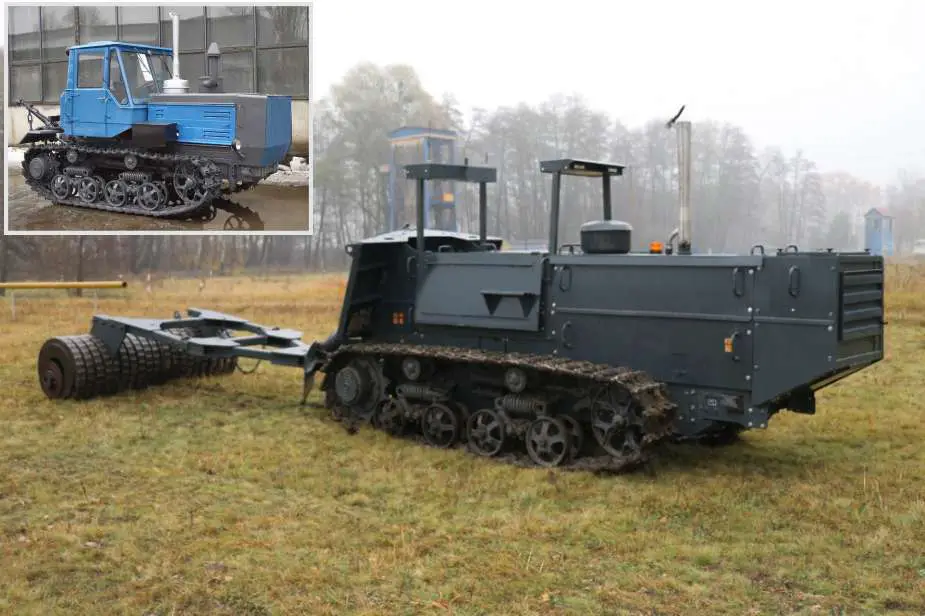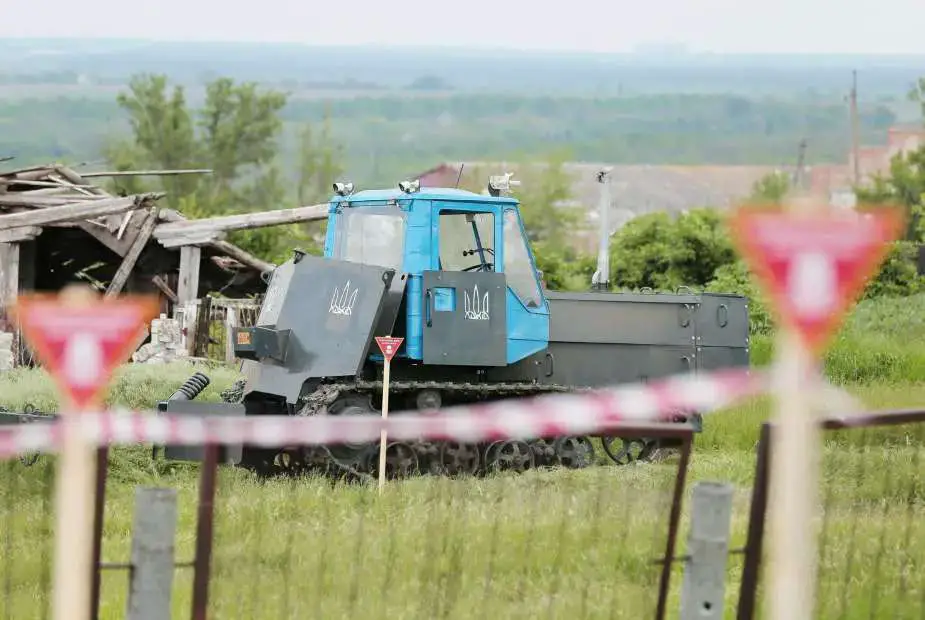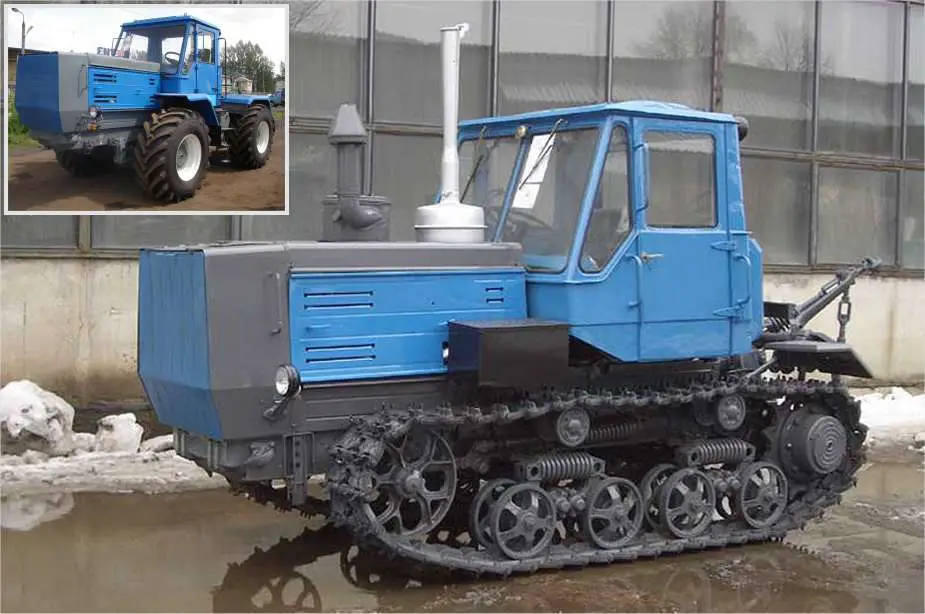Ukraine transforms farm tractors into remote-controlled demining vehicles
As reported by Militarnyi on October 28, 2023, the State Emergency Service of Ukraine (DSNS) received its first domestically produced unmanned ground vehicle (UGV) designed for demining tasks during a demonstration in Kharkiv. This UGV appears to be based on a T-150-05-09, a tracked tractor manufactured by KhTZ (Kharkiv Tractor Plant). The T-150 can be configured as either wheeled or tracked.
Follow Army Recognition on Google News at this link

This new mine-clearing UGV is based on a tracked farm tractor KhTZ T-150-05-09 (Picture source: DSNS and Yandex)
Oleg Sinyegubov, the head of the Kharkiv Regional State Administration (OVА), mentioned that this UGV is the ninth demining machine operating in Kharkiv Oblast, but it is the first of local production, with a cost of 5.6 million Ukrainian hryvnias (approximately €145,144 or $154,761) funded through the regional budget of Kharkiv Oblast. Furthermore, another unit is expected to be available to DSNS rescuers by the end of November, also funded by the regional budget.
Sinyegubov also provided information on the development and testing process of this machine. The prototype underwent four months of rigorous testing and successfully detonated over 300 anti-personnel mines during this period. This led to the issuance of a conformity certificate, as reported on August 4, 2023. The machine is constructed on the chassis of a T-150-05-09, a tractor locally produced in Kharkiv, which is easy to manufacture, operate, maintain, and repair.
The mine-clearing UGV can be operated remotely from a safe distance of 300 meters using a remote control unit. Weighing 16 tons, it operates at a speed of 3-4 km/h and is claimed to be capable of neutralizing 95% of all mines.
Operators will undergo comprehensive training programs lasting several weeks before the machine becomes fully operational. These training programs are likely to ensure that operators can safely and effectively manage the machine during demining tasks and maintain and repair it before and after these operations.
The deployment of this equipment is expected to enhance Ukraine's demining capabilities, as the country is currently confronted with a severe landmine crisis. Landmines deployed by the Russian military have created an extensive minefield covering at least an area of 250,000 square kilometers, exceeding the size of the entire Korean Peninsula (220,000 square kilometers).
The urgency of demining operations in Ukraine is rooted in the context of the Russian invasion that began in February 2022. A Globesec report from April 26, 2023, revealed that nearly 30% of Ukraine's territory, equivalent to approximately 174,000 square kilometers, is afflicted by landmines and unexploded ordnance. Demining efforts are intricate and resource-intensive, with the tactics employed by Russian forces further complicating the process. By June 2023, these efforts had resulted in the clearance of approximately 540,000 unexploded items. The World Bank estimates that the total cost of ensuring Ukraine's safety from these hazards amounts to a staggering $37 billion.
This contamination poses significant challenges, both in terms of resource allocation and economic stability, highlighting the critical role played by innovations like the domestically produced Pozhmashina PM-B and the growing demand for existing mine-clearing vehicles, such as the Slovakian Bozena-4 and Bozena-5, the Swiss Digger D-250, the German Wisent 1, and the South Korean K600 Rhino.

The first prototype of the UGV for mine clearance retained the original cab of the KhTZ T-150-05-09 agricultural tractor. (Picture source: Ukrainian Ministry of Economy)
The importance of providing demining specialists with reliable mine-clearing vehicles could explain the use of a T-150-05-09 agricultural tractor as the basis of this UGV, given that most of the tractors remain operational after several decades with minimal maintenance. In addition, these tractors often do not have onboard electronics, and the mechanics are simplified to facilitate maintenance and possible repairs.
The T-150-05-09 is a tractor manufactured by KhTZ (Kharkiv Tractor Plant), also known as HTZ, that can be configured as either wheeled or tracked. It features an electric starter, a hydromechanical transmission, and the option to equip the cabin with an air conditioner. In terms of general specifications, it has a length of 5000 mm, a width of 1880 mm, a height of 3375 mm, a base of 1800 mm, a track width of 1435 mm, a ground clearance of 300 mm, and an operating weight of 8150 kg. The fuel tank has a capacity of 315 liters.
The T-150-05-09 is powered by the YaMZ-236D-3 engine, a V6 water-cooled diesel engine with a displacement of 11.15 liters. It is designed to operate in a temperature range from -60°C to 50°C and can function effectively in mountainous conditions at altitudes of up to 4,650 meters above sea level. The engine produces 175 horsepower at 2,100 rpm.
In its wheeled configuration, the T-150-05-09 can deliver a traction force of 4,000 kgf, equivalent to 39,226 Newton meters (Nm). This versatility makes it suitable for various agricultural and industrial applications, providing reliable performance in different environmental conditions, whether in tracked or wheeled form.
This UGV appears to use the reverse gear of the original tractor as a forward gear. In fact, everything is reversed, as shown by the position of the front grille. The engine, whose bonnet is now either covered or made of armor plate, is in the rear position, and, on the first prototypes, the cab appeared to be inverted, which turns out to be a simple optical illusion.
This choice is logical because, unlike normal agricultural work such as plowing or silage harvesting, where the machine can pull the agricultural tool, this UGV has to push the mine clearance tool. Without this simple consideration, the tractor would be rendered unusable in the event of an encounter with a mine. Especially as the undercarriage, including the tracks, seems to have remained strictly original: a single shrapnel could easily reach and pass through the engine, for example.
What's more, reversing the tractor offers a number of advantages in terms of use. If flails or chains are used, the demining tool can be connected to the tractor's power take-off, giving a rotation speed of between 540 and 1000 rpm. If a roller is used, as shown in the video, it can be attached via the tractor's rear hitch. The tractor appears to have a three-point attachment, which has the advantage of being able to adjust the height of the tool, making it easier to attach or detach an agricultural tool, which appears to have been the basis of the attachment system for the mine-clearing roller.
Another advantage of choosing the tracked version of the T-150 lies in the very nature of the terrain in Ukraine, which is currently muddy and uneven. Among other things, a tracked tractor provides better traction over a wider range of ground conditions, greater ability to maintain traction and stability on slopes, and better maneuverability (zero turning radius possible).

The KhTZ T-150 agricultural tractor is available in wheeled or tracked versions (Picture source: Yandex)


























